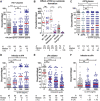The fibrinolytic system enables the onset of Plasmodium infection in the mosquito vector and the mammalian host
- PMID: 33547079
- PMCID: PMC7864569
- DOI: 10.1126/sciadv.abe3362
The fibrinolytic system enables the onset of Plasmodium infection in the mosquito vector and the mammalian host
Abstract
Plasmodium parasites must migrate across proteinaceous matrices to infect the mosquito and vertebrate hosts. Plasmin, a mammalian serine protease, degrades extracellular matrix proteins allowing cell migration through tissues. We report that Plasmodium gametes recruit human plasminogen to their surface where it is processed into plasmin by corecruited plasminogen activators. Inhibition of plasminogen activation arrests parasite development early during sexual reproduction, before ookinete formation. We show that increased fibrinogen and fibrin in the blood bolus, which are natural substrates of plasmin, inversely correlate with parasite infectivity of the mosquito. Furthermore, we show that sporozoites, the parasite form transmitted by the mosquito to humans, also bind plasminogen and plasminogen activators on their surface, where plasminogen is activated into plasmin. Surface-bound plasmin promotes sporozoite transmission by facilitating parasite migration across the extracellular matrices of the dermis and of the liver. The fibrinolytic system is a potential target to hamper Plasmodium transmission.
Copyright © 2021 The Authors, some rights reserved; exclusive licensee American Association for the Advancement of Science. No claim to original U.S. Government Works. Distributed under a Creative Commons Attribution NonCommercial License 4.0 (CC BY-NC).
Figures







Similar articles
-
Plasmodium falciparum Gametes and Sporozoites Hijack Plasmin and Factor H To Evade Host Complement Killing.Microbiol Spectr. 2023 Jun 15;11(3):e0449322. doi: 10.1128/spectrum.04493-22. Epub 2023 May 16. Microbiol Spectr. 2023. PMID: 37191558 Free PMC article.
-
Transgenic Anopheles mosquitoes expressing human PAI-1 impair malaria transmission.Nat Commun. 2022 May 26;13(1):2949. doi: 10.1038/s41467-022-30606-y. Nat Commun. 2022. PMID: 35618711 Free PMC article.
-
PIMMS43 is required for malaria parasite immune evasion and sporogonic development in the mosquito vector.Proc Natl Acad Sci U S A. 2020 Mar 31;117(13):7363-7373. doi: 10.1073/pnas.1919709117. Epub 2020 Mar 12. Proc Natl Acad Sci U S A. 2020. PMID: 32165544 Free PMC article.
-
Bacterial plasminogen activators and receptors.FEMS Microbiol Rev. 2001 Dec;25(5):531-52. doi: 10.1111/j.1574-6976.2001.tb00590.x. FEMS Microbiol Rev. 2001. PMID: 11742690 Review.
-
Beyond cuts and scrapes: plasmin in malaria and other vector-borne diseases.Trends Parasitol. 2022 Feb;38(2):147-159. doi: 10.1016/j.pt.2021.09.008. Epub 2021 Oct 11. Trends Parasitol. 2022. PMID: 34649773 Free PMC article. Review.
Cited by
-
Crystal structure of Aedes aegypti trypsin inhibitor in complex with μ-plasmin reveals role for scaffold stability in Kazal-type serine protease inhibitor.Protein Sci. 2022 Feb;31(2):470-484. doi: 10.1002/pro.4245. Epub 2021 Nov 29. Protein Sci. 2022. PMID: 34800067 Free PMC article.
-
Novel hydrazone compounds with broad-spectrum antiplasmodial activity and synergistic interactions with antimalarial drugs.Antimicrob Agents Chemother. 2024 Jun 5;68(6):e0164323. doi: 10.1128/aac.01643-23. Epub 2024 Apr 19. Antimicrob Agents Chemother. 2024. PMID: 38639491 Free PMC article.
-
Functional human IgA targets a conserved site on malaria sporozoites.Sci Transl Med. 2021 Jun 23;13(599):eabg2344. doi: 10.1126/scitranslmed.abg2344. Sci Transl Med. 2021. PMID: 34162751 Free PMC article.
-
Anopheles salivary apyrase regulates blood meal hemostasis and drives malaria parasite transmission.bioRxiv [Preprint]. 2023 May 22:2023.05.22.541827. doi: 10.1101/2023.05.22.541827. bioRxiv. 2023. Update in: Nat Commun. 2024 Sep 18;15(1):8194. doi: 10.1038/s41467-024-52502-3. PMID: 37292610 Free PMC article. Updated. Preprint.
-
Mosquito salivary apyrase regulates blood meal hemostasis and facilitates malaria parasite transmission.Nat Commun. 2024 Sep 18;15(1):8194. doi: 10.1038/s41467-024-52502-3. Nat Commun. 2024. PMID: 39294191 Free PMC article.
References
-
- Wu P., Sun P., Nie K., Zhu Y., Shi M., Xiao C., Liu H., Liu Q., Zhao T., Chen X., Zhou H., Wang P., Cheng G., A gut commensal bacterium promotes mosquito permissiveness to arboviruses. Cell Host Microbe 25, 101–112.e5 (2019). - PubMed
Publication types
Grants and funding
LinkOut - more resources
Full Text Sources
Other Literature Sources

